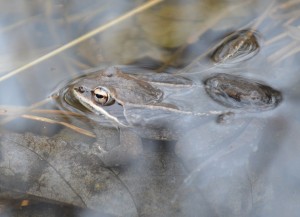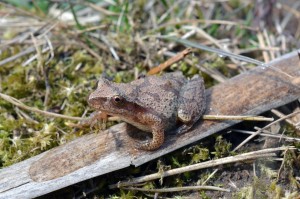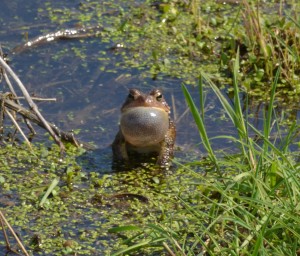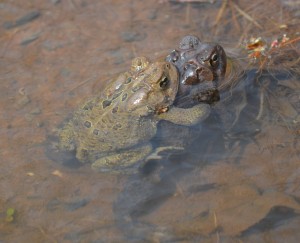Here’s a critter quiz for you! What animal lives in water (for the early part of its life), lays eggs, sounds like a duck quacking, but is not a duck? If you still guessed a duck, you should take the quiz again! If you guessed a Wood Frog (I know, why would you guess a frog?), congratulations, you’re correct! The calls of the male Wood Frog sounds just like quacking ducks, and right now they’re busy doing their best imitations of the feathered versions!

The calendar may read that spring is still a couple weeks away, but nature is well underway with its annual transition to a new season-especially with the crazy warm spell of weather we had in February. One group of critters that has already been active with the early spring weather are the amphibians-specifically, a few species of frogs and salamanders.
Click below to hear the call of the Wood Frog
Every year in late winter/early spring, certain areas of forests come alive with these animals that travel to small, temporary wetlands, called vernal pools, to breed and lay their eggs. Vernal pools are like large puddles found in woodlands that only appear for a few months every year. In Pennsylvania, late fall rains and winter snow/ice melt fill these low areas with water where salamanders species like Spotted and Jefferson, as well as Wood frogs, migrate to breed and lay eggs. Vernal pools usually do not hold any fish. If you remember your basic biology lesson, these species need water for this part of their life cycle. But since these small forested pools dry up by late spring, their “window” to find these wetlands, do their thing and make baby salamanders and frogs is very narrow. I’ve even seen Wood frogs begin breeding in vernal pools when there’s still pockets of ice in them. It’s very important that we recognize these small, seasonal wetlands and continue to protect them. Unless you’re in the right spot, at the right time, you may not see the salamander’s migration/use of these vernal pools. This usually happens on warm, rainy nights, and these animals don’t vocalize like the frogs. But, those quacking Wood frogs, they’re not shy about sounding off! It’s the males calling feverishly to attract girlfriends, so they can, well, you know!
The woodland amphibians aren’t the only ones that become active in early spring. If you venture near other wetlands, edges of lakes, cattail marshes or ponds, you’ll probably hear the calls of the tiny (almost invisible) Spring peeper. These tiny frogs may only be an inch long, but groups of them together can produce very loud choruses that drown out any other sounds around them! Like most frogs (and toads) they do this by inflating air in their throats and letting it out very quickly. “Peep, peep, peep,” they call out, but if you try to sneak up on one to find where the sound is coming from, the peeping stops, and all goes quiet. Turn around and walk away, and their calls begin again-a kind of amphibian “cat and mouse game.” I can just imagine a few of these little froggies, hiding in a stand of cattails, alternating between calling and quiet, laughing at me every time I get close with my camera! Some of these animals aren’t as elusive, and sometimes don’t even care if you’re standing among them-the toads. Click below to hear the mighty call of the Spring Peeper

American toads (Bufo americanus) are common toads of eastern and central U.S. They’re brownish-grey with many “wart-like” bumps on their bodies. No, they will not give you warts if you touch one. However, if you handle one, you may get some skin irritation since they have small poison sacs right behind their eyes, which are used as a defense against predators. They like to hop around gardens, parks and backyards in search of insects, worms and slugs. But the real action starts when it’s breeding time! Males will move into marshes, ponds or even drainage ditches in hopes of attracting a female. The males will begin calling a long trill that may last as much as 30 seconds. When the breeding action gets hot and heavy, watch out! I was standing on the edge of a small wetland a couple years ago trying to get some photos, when several males swam over to me and tried mating with the side of my hip boots. I blushed a bit, but decided not to photograph them, in case any of their toad buddies were watching!
Click below to hear the trills of the American Toad
Spring is upon us, and with it comes the wonderful world of amphibians! As the snow melts and rain falls, salamanders and frogs make their way to vernal pools. Some move quietly in the dark of night, while others let us know they’re around by their peeps, trills and quacks! Enjoy, and get out and about this spring!

